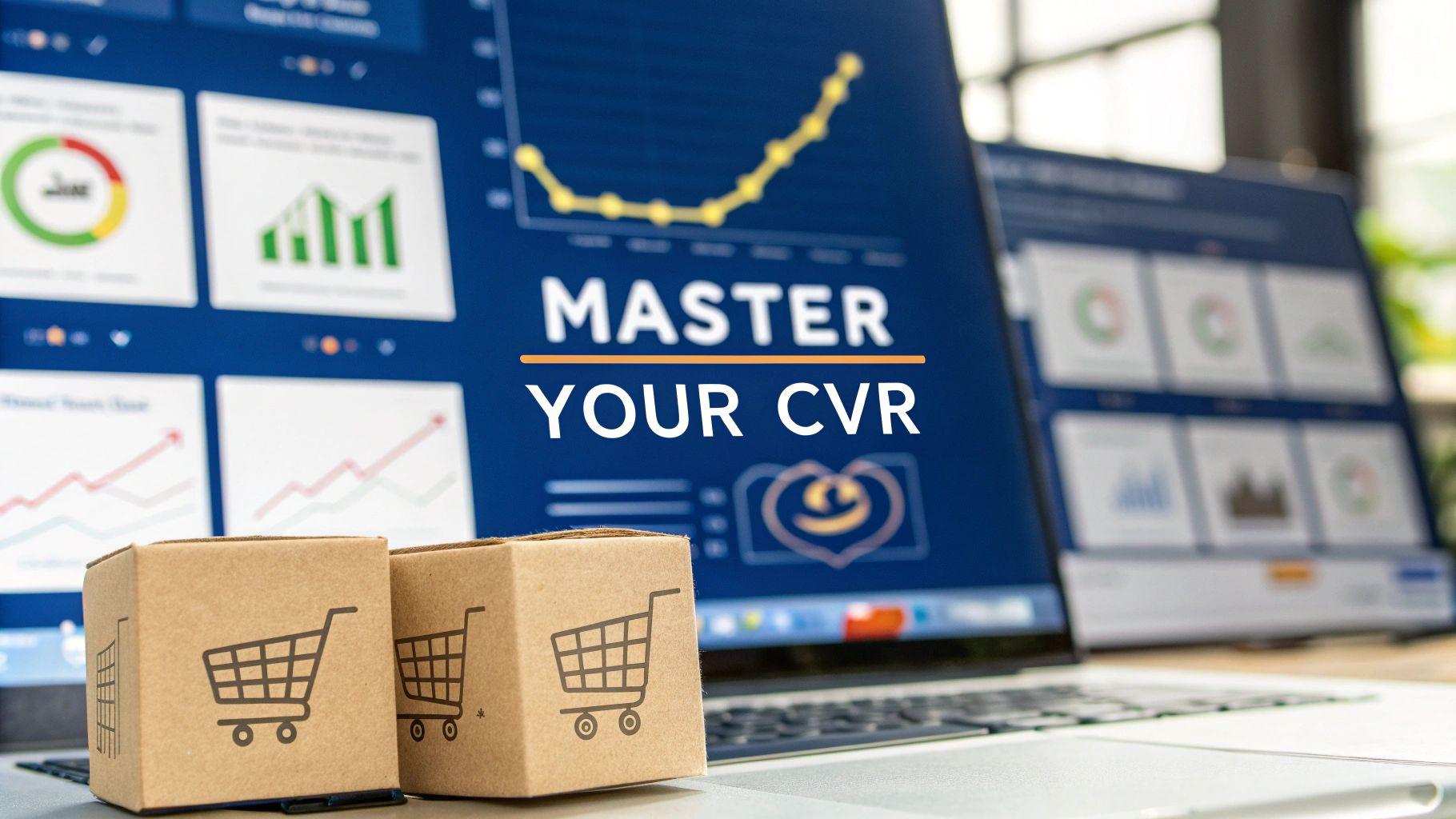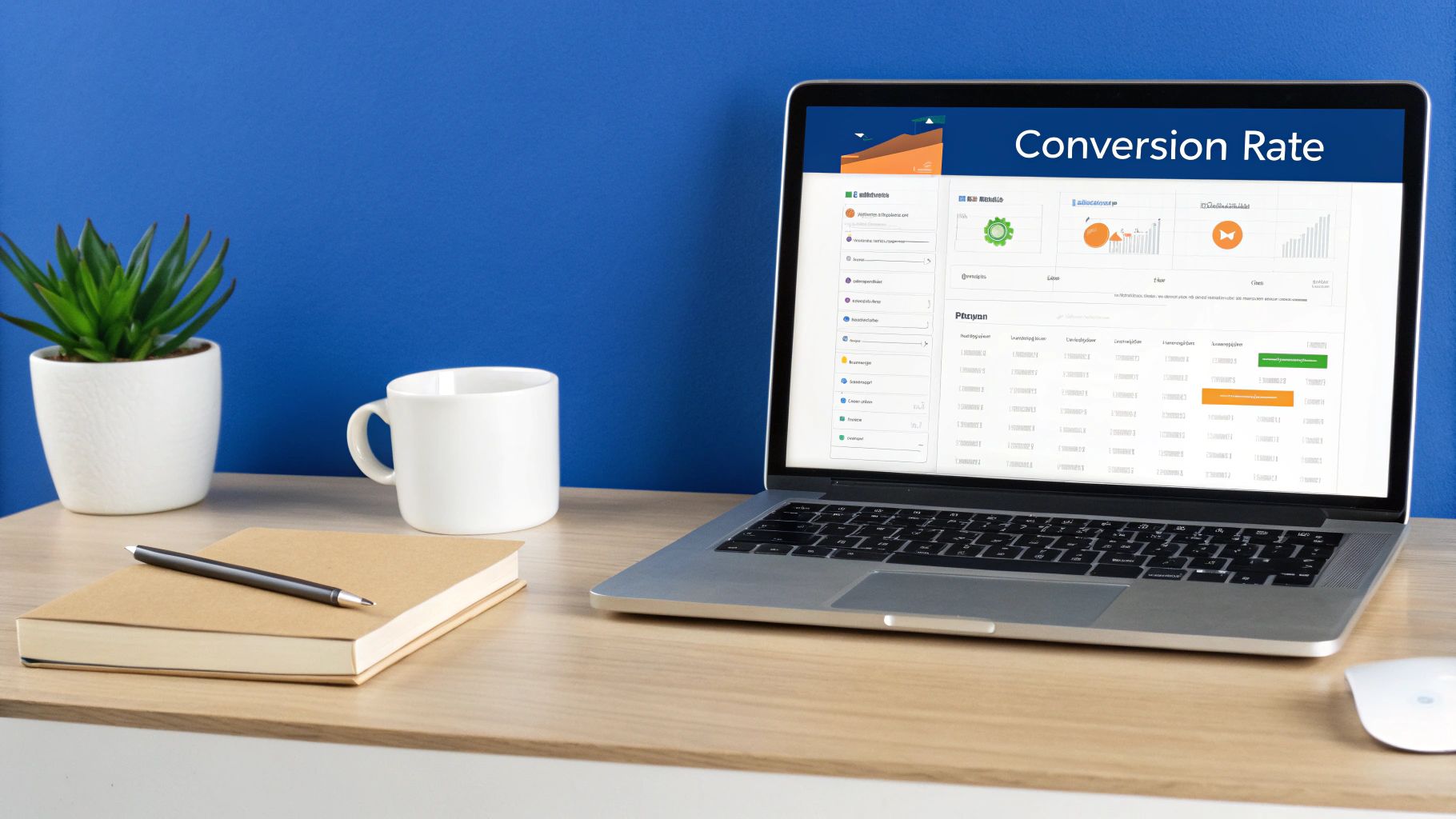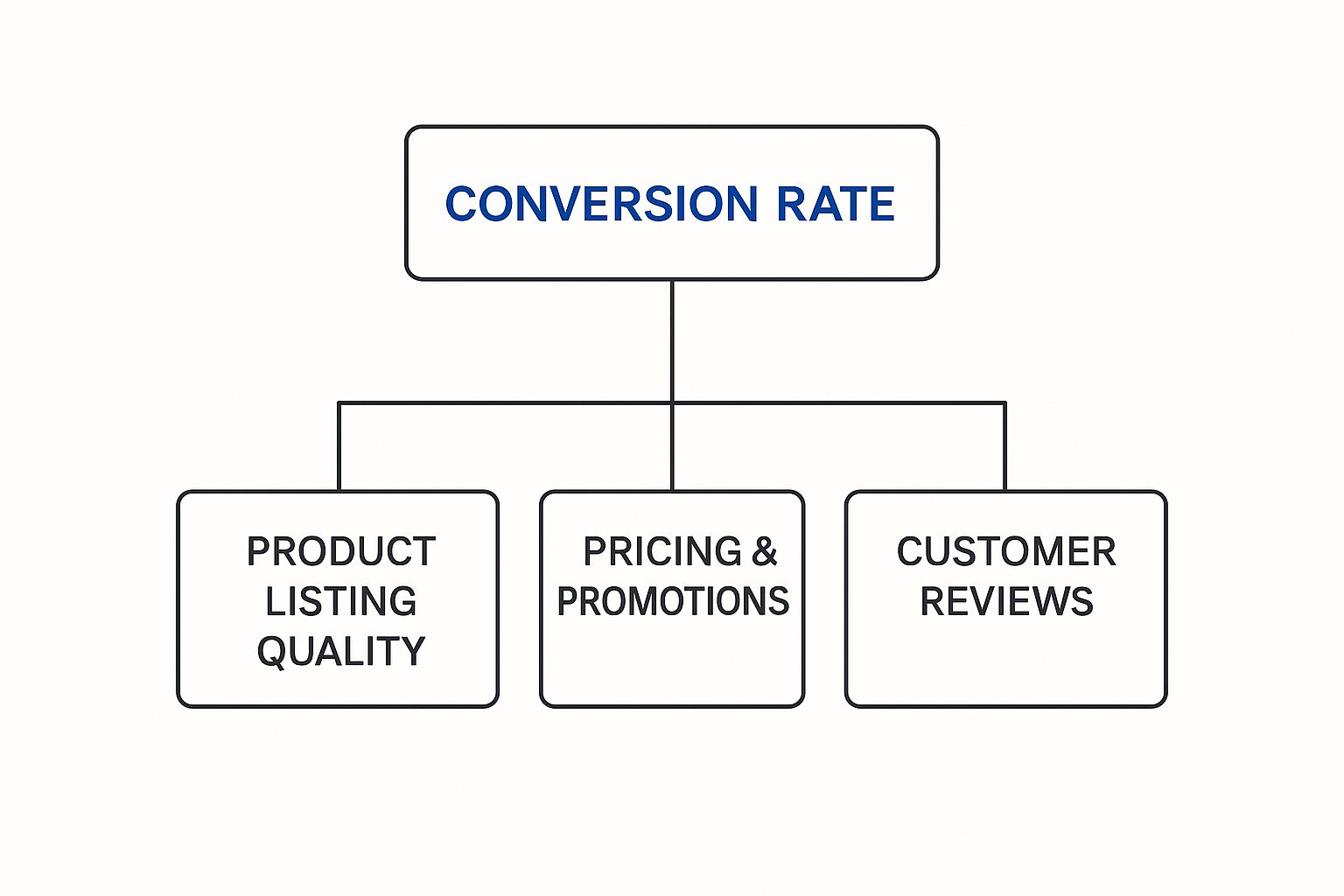Mastering Your Amazon Conversion Rate for Profitable Scale
A complete guide to calculating and improving your Amazon conversion rate. Learn data-backed strategies to boost profitability and drive organic growth.

Your Amazon conversion rate (CVR) is the percentage of shoppers who land on your product page and complete a purchase. In a marketplace where intent is sky-high, it's the single most critical performance metric for building a profitable, scalable brand.
Let's put this in context. The average eCommerce website converts at a meager 1.33%. On Amazon, the platform average is a staggering 9.87%. This data tells a clear story: shoppers on Amazon aren't just browsing; they are primed to buy. Your job is to ensure your listing closes the deal.
Why Your Conversion Rate Is The Ultimate Growth Metric

It’s easy for eCommerce leaders to get distracted by vanity metrics like traffic or impressions. But those numbers don't impact your P&L. Your conversion rate, however, is a direct reflection of your product's market fit, messaging, and pricing strategy. It's the ultimate health check for your Amazon business.
A high CVR sends a powerful signal to Amazon's A9 algorithm: shoppers who find your product, buy your product. This directly boosts your organic search ranking, creating a powerful flywheel effect. Better conversions lead to more visibility, which drives more traffic, which leads to even more sales. This is the foundation of sustainable growth.
The True Impact of CVR on Profitability
A strong conversion rate isn't a passive outcome; it's an active lever for profitability. By improving the conversion of your existing traffic, you're not just making more sales—you're making your entire operation more efficient and defensible.
- Improve Ad Spend Efficiency: A higher CVR means every ad dollar works harder. Each click you pay for is more likely to result in a sale, lowering your Advertising Cost of Sale (ACoS) and directly increasing your return on investment.
- Fuel Organic Ranking: As mentioned, Amazon's algorithm rewards products that convert. Better organic placement reduces your long-term reliance on paid advertising, building a more sustainable and profitable sales mix.
- Build Brand Moat: High-converting products accumulate positive reviews and ratings. This social proof builds trust, reduces friction for future customers, and solidifies your brand as a category leader.
The performance gap is significant. Walmart, for example, sees an average conversion rate of around 6%. The data is clear: Amazon's high-intent environment provides a unique opportunity, and a brand's CVR is the key to capitalizing on it. You can find more stats on this at the PushPull Marketing Agency.
The Headline Takeaway: Stop viewing your conversion rate as a passive KPI. It is an active tool for strategic decision-making. Improving CVR isn't just about 'selling more'—it’s about building a more profitable, stable, and scalable brand on Amazon by maximizing the value of every single visitor.
How To Calculate And Benchmark Your Performance

You can't optimize what you don't measure. For any brand leader on Amazon, data-driven decision-making starts with a deep understanding of core performance metrics.
On Amazon, your conversion rate is officially called the Unit Session Percentage Rate. This is the key metric that precisely measures the percentage of sessions on your product page that resulted in a purchase.
Finding this data is straightforward.
Calculating Your Unit Session Percentage Rate
Log into your Amazon Seller Central account. Navigate to the Reports tab and select Business Reports. From there, access the Detail Page Sales and Traffic report for a specific ASIN or your entire catalog.
This report provides the two data points needed for a simple calculation:
Unit Session Percentage Rate = (Total Units Ordered / Total Sessions) x 100
Monitoring this metric over time is the foundation of an intelligent advertising and growth strategy. It allows you to directly correlate your marketing efforts with business outcomes, especially when analyzing your Total Advertising Cost of Sales (TACoS) to connect ad spend with holistic growth.
Setting Realistic Performance Benchmarks
Knowing your conversion rate is the first step. The next is understanding what it means in the context of your market.
There is no single “good” conversion rate. It's a dynamic benchmark influenced by your product's price point, category, and competitive landscape.
A well-optimized product on Amazon often achieves a conversion rate between 10% and 15%. However, this is a general guideline. A high-ticket electronic item will naturally convert lower than a low-cost, consumable CPG product.
To help you set more accurate targets, here is a breakdown of typical CVRs based on key influencing factors.
Amazon Conversion Rate Benchmarks By Key Factors
A summary of typical Amazon conversion rate ranges based on different influencing factors, helping brands set realistic performance targets.
| Factor | Low CVR Range | Average CVR Range | High CVR Range (e.g., Prime Members) |
|---|---|---|---|
| Product Price | 1-5% (High-ticket items >$200) | 8-12% (Mid-range items $30-$100) | 15-25% (Low-cost impulse buys <$20) |
| Product Category | 3-7% (Electronics, high-fashion) | 10-15% (Home goods, supplements) | 20-30% (Groceries, everyday essentials) |
| Traffic Source | 2-6% (External traffic from social media) | 9-14% (Amazon search traffic) | 25-40% (Highly targeted brand search) |
| Competition Level | 4-8% (Highly saturated categories) | 10-16% (Moderately competitive) | 18-25% (Niche or emerging categories) |
These ranges illustrate the importance of context. Your objective shouldn't be to hit a universal number, but to establish a realistic benchmark for your brand and product portfolio. Track your Unit Session Percentage Rate, benchmark against direct competitors, and focus on consistent, incremental improvement. This is how a simple metric becomes a powerful tool for sustainable growth.
The Core Pillars That Drive Conversions
Knowing your Amazon conversion rate is step one. Systematically improving it is where brand leaders separate themselves from the competition. While countless details influence a shopper, a few core pillars carry the most weight. Focusing your resources here will yield the most significant and immediate returns.
These pillars are interdependent. They work in concert to build confidence, answer questions, and eliminate friction in the few seconds you have a shopper's attention.

Success on Amazon is not a matter of luck. It is the direct result of operational excellence across product presentation, pricing, and customer trust signals.
Masterful Listing Optimization
Your product detail page is your digital retail presence. It must function as your best salesperson, anticipating and answering every question a shopper might have. A poorly optimized listing is a primary source of conversion leakage.
Effective optimization is a blend of clarity and persuasion.
- Compelling Titles and Bullets: These must be optimized for search with relevant keywords but written for humans. They should immediately convey the primary benefit and key features, reducing the cognitive load for the shopper.
- A+ Content: This is your opportunity for brand storytelling and deeper product education. Use high-quality lifestyle imagery and comparison charts to help customers visualize the product in their lives and differentiate it from competitors.
- Video: Video is the most effective tool for demonstrating features and building purchase confidence. A well-produced video can significantly increase conversion, acting as the closest substitute for an in-person product experience.
Strategic Pricing and Promotions
Price is a primary conversion driver, but it’s not about a race to the bottom. The goal is to demonstrate compelling value. Your pricing must be dynamic and informed by market conditions.
Leveraging accurate competitor pricing data is essential for maintaining competitiveness without eroding margins. Strategic promotions like Lightning Deals or coupons can create urgency and drive significant short-term sales velocity, which in turn influences organic rank.
Unbeatable Reviews and Social Proof
In the vast Amazon marketplace, trust is a currency. Shoppers rely heavily on the experiences of others to validate their purchase decisions. A strong foundation of positive reviews is a non-negotiable prerequisite for a healthy conversion rate.
A product with hundreds of 4.5-star reviews will consistently outperform a similar product with a handful of perfect 5-star ratings. Volume and consistency signal reliability and reduce perceived purchase risk.
This social proof tells new customers that your product is a safe, proven choice, making it far easier for them to click "Add to Cart."
The Power of Prime Fulfillment
Never underestimate the conversion power of the Prime badge. For millions of Amazon shoppers, products not available with fast, free Prime shipping are effectively invisible.
Fulfillment by Amazon (FBA) is more than a logistics solution; it's a conversion optimization tool.
- Increased Trust: The Prime badge signals that Amazon is handling fulfillment, which provides customers with immense peace of mind.
- Faster Delivery: In an on-demand economy, Prime’s delivery promise is a powerful competitive advantage.
- Better Visibility: Amazon’s search algorithm inherently favors FBA listings, providing an immediate lift in search placement.
Data proves the power of Amazon's endorsements. The "Best Seller" badge can increase a product's traffic by an average of 45%, while the "Amazon's Choice" badge can boost conversion rates by 25%. Both of these are heavily influenced by sales velocity, a metric that FBA directly supports.
Advanced Strategies To Systematically Boost Your CVR

With a solid foundation in place, it's time to elevate your approach. Pushing your Amazon conversion rate to the next level requires moving beyond one-off fixes and building a system of continuous improvement.
This means shifting from intuition-based decisions to a data-driven optimization process. The goal is to create a constant feedback loop—test, learn, iterate—where small, intelligent changes compound into significant performance gains over time.
Build a Data-Driven Testing Framework
Amazon’s Manage Your Experiments tool is the key to this process. It enables you to A/B test critical listing elements—your main image, title, and A+ Content—to see what truly drives conversions. No more guesswork.
For example, a home goods brand might test two main images: a clean studio shot versus a lifestyle image showing the product in a decorated room. Running an experiment provides definitive, quantitative data on which asset performs better.
A real-world example: one kitchenware brand discovered that a title including the phrase “BPA-Free Silicone” converted 15% higher than one highlighting “Easy to Clean.” This single insight was then scaled across their entire product catalog for an immediate lift in sales.
The cardinal rule of testing: test one variable at a time. Changing the title and the main image simultaneously will corrupt your data, making it impossible to determine which change drove the result. Maintain clean tests to generate actionable insights.
Implementing effective customer journey optimization strategies provides a broader framework for refining every touchpoint and systematically increasing your CVR.
Leverage Advanced Keyword and Competitor Insights
A high conversion rate begins with attracting the right traffic. This requires digging deeper than high-volume, generic keywords to find long-tail, high-intent phrases that signal a user is in the final stages of their purchase journey.
Consider the difference in intent. A search for "running shoes" is exploratory. A search for "lightweight trail running shoes for wide feet" is a purchase-ready query. If your product meets that specific need, the probability of conversion is exponentially higher.
Use Amazon's Search Query Performance report to uncover these opportunities. Look for terms with a high click-through rate and conversion rate, even if search volume is moderate. These often represent underserved niches.
Next, conduct a forensic analysis of your top three competitors:
- Analyze Q&A: What questions are shoppers asking? Proactively answer these in your own bullet points or A+ Content to remove friction.
- Mine Negative Reviews: What are customers complaining about? If they mention a competitor's product is fragile, highlight your product's durability. You are directly addressing and solving a known pain point.
- Identify Content Gaps: If they lack a product video or lifestyle imagery, adding these to your listing creates an immediate competitive advantage.
Recapture Lost Sales with Strategic Retargeting
Not every visitor will convert on their first visit. Shoppers compare options, get distracted, or wait for payday. This is normal, and Amazon's advertising suite provides tools to re-engage them.
Using Sponsored Display ads, you can specifically retarget shoppers who viewed your product but did not purchase within a defined lookback window (e.g., 30 days). This is a highly efficient tactic for staying top-of-mind and bringing qualified traffic back to your listing to complete the purchase.
These retargeting campaigns almost always yield a higher conversion rate than campaigns targeting cold traffic. You're engaging a warm audience that has already demonstrated interest. It’s a simple but powerful strategy to plug leaks in your sales funnel and maximize the value of your initial traffic acquisition efforts.
Using PPC To Fuel Your Organic Growth Engine
It's time for a paradigm shift: Amazon PPC is not just an advertising expense. For sophisticated brands, it is a strategic investment designed to kickstart the flywheel of long-term organic growth.
The goal isn't just to buy sales. It's to use paid traffic to generate the performance data—specifically, sales velocity and a high Amazon conversion rate—that signals to the A9 algorithm that your product is highly relevant and deserves top organic placement.
When you use targeted ads to drive your initial wave of sales, those conversions tell Amazon that shoppers who see your product, buy it. The algorithm is designed to elevate products that satisfy customer intent, so it rewards high-converting products with better organic search rankings. This increased visibility drives more "free" organic traffic and sales, further solidifying your sales history and conversion data, creating a self-sustaining growth loop.
Structuring PPC for Maximum Conversion
To ignite this flywheel, your PPC campaigns must be engineered for one primary goal: conversion. This requires a strategic shift away from chasing broad, high-impression keywords toward specific, high-intent search terms that capture shoppers at the moment of purchase.
Focusing on these purchase-ready shoppers makes every ad dollar more productive.
- Prioritize Long-Tail Keywords: Instead of a generic term like "headphones," target specific phrases like "noise-canceling headphones for air travel." Shoppers using these terms have higher intent and a much greater likelihood of converting.
- Use Precise Targeting: Go beyond keywords. Leverage Amazon's product and audience targeting to place ads on competitor detail pages or to retarget shoppers who previously viewed your product.
- Optimize for Profitability: Continuously monitor campaign performance. A keyword generating high clicks but zero sales is actively harming your conversion rate and wasting budget. Prune underperforming targets ruthlessly.
Adopting this performance-first mindset ensures that your paid traffic is primed to convert, providing the strongest possible proof of relevance to Amazon's algorithm.
Your PPC strategy should not just capture existing demand; it must prove your product’s superiority to Amazon. A high CVR from paid traffic is the most compelling evidence you can provide.
The CVR Flywheel Effect: PPC vs. Organic Growth
This table illustrates the cause-and-effect relationship between a conversion-focused PPC strategy and long-term organic rank. Paid advertising acts as the catalyst for sustainable, free visibility.
| Strategic Action (PPC) | Immediate Impact (CVR) | Long-Term Outcome (Organic Rank) |
|---|---|---|
| Bid on high-intent, long-tail keywords | Attracts shoppers ready to buy, increasing CVR. | A9 algorithm sees high relevance, boosts organic rank for those terms. |
| Run targeted ads on competitor listings | Captures qualified traffic, leading to more sales. | Sales velocity increases, signaling market demand to Amazon. |
| Pause low-converting, high-click keywords | Stops wasting budget and improves the overall campaign CVR. | A higher overall CVR tells Amazon your product is a top choice. |
| Launch new products with aggressive PPC | Generates initial sales history and reviews quickly. | Product gains traction faster, accelerating its organic ranking journey. |
Each action within your paid campaigns sends a direct, positive signal to Amazon's organic algorithm. This is how you transform an advertising cost into a long-term, appreciating asset.
The Financial Case for a CVR-Focused PPC Strategy
This approach not only boosts organic rank but also dramatically improves ad spend efficiency. In 2024-2025, the average cost-per-click (CPC) on Amazon Ads is approximately $0.99. With an average advertising conversion rate of 9.96%, sellers convert roughly one in ten ad clicks into a sale. You can explore more Amazon advertising statistics to benchmark performance across categories.
When your campaigns are structured to attract high-intent buyers, you improve upon this already strong baseline. A higher conversion rate directly lowers your ACoS (Advertising Cost of Sale) and increases overall profitability. To dive deeper into the mechanics, you can learn more about Amazon Pay-Per-Click in our detailed guide.
Ultimately, every sale generated from a strategically targeted PPC campaign performs double duty: it delivers immediate revenue while simultaneously strengthening the organic foundation of your business. This is how you escape the "pay-to-play" cycle and build a self-sustaining engine for growth.
Your Path to Lasting Profit on Amazon
Mastering your Amazon conversion rate is not about quick fixes or tactical hacks. It's about building a fundamentally stronger, more profitable, and more defensible business. The strategies covered—from listing optimization to performance-driven PPC—are not a checklist of isolated tasks. They are interconnected components of a single, powerful growth engine.
Your conversion rate is the most honest form of market feedback you can receive. It is a direct measure of how well your product, price, and messaging resonate with your target audience at the moment of truth. A low CVR is not a failure; it is a diagnostic tool that tells you exactly where to focus your efforts.
Tying It All Together for the Biggest Impact
Sustainable, compounding growth on Amazon occurs when all strategic efforts work in harmony. A perfectly optimized listing cannot salvage a flawed pricing strategy, and a brilliant PPC campaign is wasted if it drives traffic to a page that fails to convert.
An integrated, performance-first approach looks like this:
- Your listing optimization proactively addresses customer concerns, building trust and reducing purchase friction.
- Your pricing strategy is competitively positioned to communicate value without sacrificing margin.
- Your PPC campaigns are precision-targeted to high-intent shoppers, feeding Amazon's A9 algorithm the conversion data it needs to reward you with organic visibility.
This is the flywheel in action. Paid traffic proves your product's relevance, which boosts organic rank, which drives more profitable sales and solidifies your market position. Each component reinforces the others, creating a virtuous cycle of growth that is difficult for competitors to disrupt.
Treat your Amazon conversion rate as the ultimate health metric for your brand. It is a direct measure of your product's desirability and the effectiveness of your overall strategy. A relentless focus on improving it is the most direct path to profitable, long-term scale.
Your Takeaway
Stop viewing your conversion rate as a passive outcome. It is a lever that you must actively control. When you integrate best-in-class creative with data-driven advertising, you transition from simply selling products to building a dominant brand.
At Headline, we architect these integrated strategies. We connect the dots between PPC performance and organic growth, transforming ad spend into a long-term asset that fuels sustainable profitability. This performance-first mindset is how you win on Amazon.
Frequently Asked Questions
When it comes to Amazon conversion rates, even experienced eCommerce leaders have questions. It's a complex metric with multiple inputs. Here are direct answers to the most common queries we encounter.
What Is a Good CVR for My Category?
There is no universal "good" conversion rate. Performance is highly contextual and varies significantly based on product category and price point.
For most well-managed products, a CVR between 5% and 20% is a healthy range. However, instead of fixating on a generic number, the most effective approach is to benchmark against your direct competitors.
For example, a premium consumer electronics product may be performing exceptionally well at a 7% conversion rate. In contrast, a popular, low-cost consumable good could easily exceed 25%. The goal is to analyze the top performers in your specific niche to set a realistic and ambitious target for your product.
How Long Does It Take to See CVR Improvements?
The timeline for seeing results depends directly on the scope of the change implemented.
- Minor Adjustments (Days): For tactical changes—such as updating a main image, refining a title, or adding a coupon—you can often see a measurable impact within a few days to a week.
- Major Overhauls (Weeks): For more significant initiatives—like a complete A+ Content redesign, producing a new product video, or executing a formal A/B test—it will take several weeks to accumulate statistically significant data to validate the impact. Patience is key to generating clean, actionable insights.
Can a High CVR Ever Be a Bad Thing?
Counterintuitively, yes. While almost always a positive indicator, an anomalously high conversion rate should be monitored in conjunction with your product return rate.
If a spike in CVR is followed by a corresponding spike in returns, it may indicate that your product listing is overpromising or setting incorrect customer expectations. This can lead to negative reviews, which will ultimately harm your conversion rate and brand reputation in the long term. The goal is to ensure a high CVR is driven by genuine customer satisfaction, not a misleading listing.
At Headline Marketing Agency, we translate these complex questions into actionable, data-driven strategies. We don't just optimize your Amazon conversion rate—we build profitable, sustainable growth systems for ambitious brands. Learn how we drive performance at https://headlinema.com.
Wollen Sie Ihre Amazon PPC-Performance aufs nächste Level bringen?
Lassen Sie Ihre Amazon PPC-Kampagnen professionell analysieren und entdecken Sie neue Wachstumsmöglichkeiten.